#there was an actual historical samurai family that did this
Text

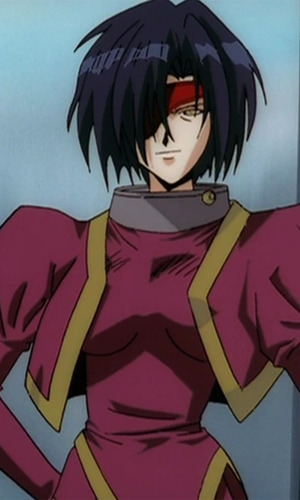

#dead moms older sister#defacto head of the mothers family#a family specifically tactically built around marrying their daughters into strong political families#there was an actual historical samurai family that did this#their daughters accounted for a hugely disproportionate number of emperors wives#but in her case the lord she was arranged to seduce was the big jolly guy from earlier#who i forgot to mention is gay#so understanding his preferences she won his favor by beating all his best samurai and fighting him to a standstill personally#and they live a mutually happy life as sexually and romantically univolved married business partners#they would each openly profess the other to be their best friend and most trusted confidant#she has no affection for her little lord nephew but would happily kill on his behalf#even if only to maintain her own family's political ties#and maybe to honor her late sister#that l5r campaign i never ran...
2 notes
·
View notes
Text
The nazis that you see in movies are as much a historical fantasy as vikings with horned helmets and samurai cutting people in half.
The nazis were not some vague evil that wanted to hurt people for the sake of hurting them. They had specific goals which furthered a far right agenda, and they wanted to do harm to very specific groups, (largely slavs, jews, Romani, queer people, communists/leftists, and disabled people.)
The nazis didn't use soldiers in creepy gas masks as their main imagery that they sold to the german people, they used blond haired blue eyed families. Nor did they stand up on podiums saying that would wage an endless and brutal war, they gave speeches about protecting white Christian society from degenerates just like how conservatives do today.
Nazis weren't atheists or pagans. They were deeply Christian and Christianity was part of their ideology just like it is for modern conservatives. They spoke at lengths about defending their Christian nation from godless leftism. The ones who hated the catholic church hated it for protestant reasons. Nazi occultism was fringe within the party and never expected to become mainstream, and those occultists were still Christian, none of them ever claimed to be Satanists or Asatru.
Nazis were also not queer or disabled. They killed those groups, before they had a chance to kill almost anyone else actually. Despite the amount of disabled nazis or queer/queer coded nazis you'll see in movies and on TV, in reality they were very cishet and very able bodied. There was one high ranking nazi early on who was gay and the other nazis killed him for that. Saying the nazis were gay or disabled makes about as much sense as saying they were Jewish.
The nazis weren't mentally ill. As previously mentioned they hated disabled people, and this unquestionably included anyone neurodivergent. When the surviving nazi war criminals were given psychological tests after the war, they were shown to be some of the most neurotypical people out there.
The nazis weren't socialists. Full stop. They hated socialists. They got elected on hating socialists. They killed socialists. Hating all forms of lefitsm was a big part of their ideology, and especially a big part of how they sold themselves.
The nazis were not the supervillians you see on screen, not because they didn't do horrible things in real life, they most certainly did, but because they weren't that vague apolitical evil that exists for white American action heros to fight. They did horrible things because they had a right wing authoritarian political ideology, an ideology that is fundamentally the same as what most of the modern right wing believes.
#196#my thougts#leftist#leftism#jewish#jumblr#actually mentally ill#mental illness#neurodivergent#actually neurodivergent#world war 2#world war ii#history#queer#gay#queer history#pagan#athiest#athiesm#disability rights#communist#communism#socialist#socialism#anti conservative#anti christianity#christanity#christianity#mad pride#madpunk
27K notes
·
View notes
Text
Remember that it was explicitly stated that Toshiro was trained in ninjutsu?

(HE WAS SIX. LIKE, BY THE WAY)
(the way he has that fucking flashback always sends me btw. I know my man felt the floor sink and everything)
And most of people trained under his family's residence are ninja-coded. Since his dad has those dark, ambiguous links with powerful people, so he's likely the same.
So why is Toshiro's attire and fighting style like a samurai's?

Strictly speaking, ninjas were essentially historical mercenaries, and samurai were nobles who fought under the shogunate without a fee. They were famously guided by the Bushido Code, while ninjas were expected to be shady and fight dirty.
Essentially opposites. Which makes me think that there's a few likely intentions behind that choice:
Maybe she just wanted to drive home more clearly the culture clash between laishuro. Like Toshiro just so happened he wanted to dress like a samurai in his adventure. Maybe he's trying to avoid being recognised? Could be, but I don't think that's it
Maybe Toshiro's training and general upbringing changed as his dad became more influential. Maybe there was a possibility that he could marry up, or get adopted into noble society, who knows, thing is there was a political reason that justified trying to raise Toshiro so he's more of a diplomat than his dad probably is. But then that'd mean that his dad regretted the switch when he deemed his son "a dull man"? I'm 50/50 here, there's always a possibility that in this fantastic alliteration of Japan has some overlaps between samurai and ninja, and maybe ninjas can be nobles after all. Feels too counterintuitive to be logical though.
Maybe it's meant to highlight how different Toshiro is from his family. So visually, it singles him out and associates a certain set of values with him; And then within the story, it lends itself to some compelling ideas like: Did he do it on purpose, was it somehow decided for him as a weird punishment or something? If he did it on purpose then that'd be the very first big decision he took for himself, to say "I want to embody this". Very bold of him since it sends a clear message to everyone. It'd be kind of cool if he made the switch after his father accused him of being dull. He could feel responsible for inheriting the family and having a lot of people to his charge, but at the same time he has such a negative opinion of the type of leader his father is that the only way to reconcile his conscience would be to become the new head of the family but also lead completely different to his dad. OR maybe it was a silent way to say that he never felt like being in that position of leadership anyway. Quietly quitting, in a way? Or maybe it didn't even happen consciously. Toshiro naturally seeked role models that embodied a type of man that he could actually look up to, and slowly molded himself to that standard, for better and for worse. Strong sense of responsibility and all that.
I guesssss it could be that Toshiro's family really is nobility, but they train their servants in all of those special skills as a private bodyguard force? Hien expected Toshiro to propose to her, would that union be allowed if Toshiro's family was nobility? It's even said in one of the art books that the reason why Toshiro's dad didn't marry Maizuru is because he met her after marrying his wife. Besides, why train Toshiro in ninjutsu too? And then there's those moments when it's hinted that he's familiar with some darker dynamics. I keep thinking about how he knew what Laios group had to do in order to lose the cops fkdkkd. Anyway I can see the logic in the argument, I'm just not sure Toshiro's family isn't hiding something sus. I see it as very mafia coded. Honestly, that might be just it
In any case, it does overlap some interesting elements on Toshiro. There's an expectation on him from his family, the way the household projects an image of strength but also some shadiness, that contrasts with how he presents himself, how he's treated by his charges, how the image he projects is of a mild mannered, stoic, diplomatic man.
#tl;dr i don't think Toshiro is nobility. i think his family is important and close to power not because it was inherited but because it was#acquired through whatever it is that they do. And idk how Toshiro ended up embracing the archetype of the samurai all i know is that it's a#contrast that's intentional#dungeon meshi#rambles#dunmesh rambles
64 notes
·
View notes
Note
What are your thoughts on Tsuchimikado? You rated him at the top along with Iori and Chiemon on your F/SR tierlist on twitter, which was surprising to me because of how little screentime he got.
I feel like everything I could say about him I already said on Twitter. I'll copy-paste myself about it under the cut (with some edits since my opinions evolved with time) but in the open section of the post, I got a new comment to make.
Yes, we don't see Yasuhiro much. I agree with that. But I think that works completely to the character's benefit. It's what I've been always talking about Sayaka Maizono. Writing efficiency. Making the character feel complete with minimal screentime is always impressive. Maizono does the trick by establishing she dedicates 100% of her time to a single thing and exploring the psychological consequences of taking that thing away from her. Yasuhiro does the trick by ultimately revealing that despite the size of his action, his goal was incredibly small-time and unambitious.
Notice how both of these characterization bits are only tangential to Maizono's role as a tone-setter for the rest of the franchise and Yasuhiro's role as the background reason why the Grail War exists. They technically didn't need this and only got this out of care for fleshing them out, and most importantly, they got this in a way that doesn't distract from the actual needs of the story. That's writing efficiently.
Tweet copypastes:
FSR is a story made of blatant connections to Shimousa, which makes it easy to notice the similarities in Yasuhiro's and Douman's methods. But now knowing the background of Yasuhiro's obsession, the parallels suddenly run a lot deeper.
It was in Yasuhiro's father's generation that the Tsuchimikado family lost the authority on onmyoudou to the Koutokui family. The only way for Yasuhiro to recover from this loss is to prove himself better than Koutokui Tomosuke. And that drives him off the deep end.
It's Douman vs Seimei but with historical nobodies (down to Seimei being entirely offscreen). And it certainly feels to me like Seimei left his Grail War notes to Yasuhiro because he saw some Douman in him and wanted to offer this chance at success. Douman is Seimei's soft stop.
Yasuhiro is a big liar and manipulator, so the idea of Yasuhiro genuinely wanting to give his Grail to the shogun feels laughable, but then we hear the genuine joy in his voice when the council elder calls him better than Tomosuke. That voice crack Mikami did there is easily the best bit of voice acting in all of Samurai Remnant.
Knowing the scale of Yasuhiro's goal, you can say he won. The promise of the Waxing Moon was already enough to make him the authority on Onmyoudou, and he successfully taught Takatoshi to make the best out of his talents even if they aren’t the expected ones for the job.
I know this Digression is literally the day after he dies, but there it shows Takatoshi maintaining the status of authority instead of it immediately returning to Tomosuke, so that’s a positive sign for Yasuhiro’s goals, right?
That alone already rounds up Yasuhiro's character perfectly, but it gets better when you look up real-life context about the Tsuchimikado family that the game never tells you.
FSR is a pruned event where Yasuhiro is allowed to fulfill his goals. His father's scandals may have let the Kotokui family take over as the authority in onmyoudou, but Yasuhiro restores the Tsuchimikado by offering this ultimate miracle to the shogun.
He dies in the process but he was prepared for it. He taught Takatoshi to make the best of the talents he had to compensate for the ones he lacked. The Tsuchimikado was ultimately in good hands. Everything was perfect for him. In this pruned event.
This naturally raises one question: what happens when things don't go as he wanted? What happens in Pan-Human History. Well, I checked and the answer was... Takatoshi's son simply proved himself better than the Kotokuin and Tsuchimikado regained their status, no Waxing Moon necessary.
Yasuhiro did so much shit that he ultimately didn't need to do because he'd get what he wanted anyways exactly one generation later. The point I'm trying to make here is: Seimei is a meanie.
21 notes
·
View notes
Text
After seeing wavytam's theory, it occurred to me something. Judge said he wanted revenge on the other North Blue kings, with the implication that it had something to do with the former Germa Empire.


From the sound of it, this implies that the other kings somehow conspired together, and... I don't know, set the WG on Germa, perhaps?
See, when they talked about the Vinsmoke family having "conquered the North Blue". This seems to be talking about a ridiculously old period of time, since Yonji (or Reiju?) said that "at one time" (it says "during a certain era" ある時代の in the raw).

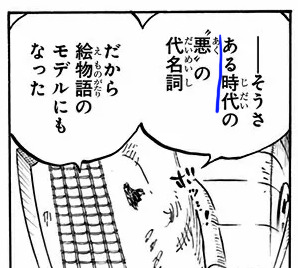
I'm guessing this must be talking about the Germa Empire from the past. It's probably not Judge's conquest of the 4 kings, or they'd have said "in my father's time". Even if the translation is wrong and it's someone else talking (in the anime, the one who was talking is Pekoms), ある時代の still implies something that happens ages ago, not just a few years or decades or so ago.
Brook said they "conquered the North Blue with military might", so I'm assuming this is why the other kingdoms don't like them for it.

Sure, if we believe the story at face value, what Germa did sounds terrible. Conquering territories sounds like tyranny.
Still, we now know from Kuma's backstory that the whole story of "Tyrant Kuma" is nonsense told to WG by the former king that he toppled. So did the other kings also went running to WG, told them a bunch of nonsense, and got Germa wiped?
Also, you know. This is not helping the conspiracy I had involving, ah, a certain historical figure. That certain someone was naturally disliked for "conquering the neighbouring lords by military might" *ahem*, but for the time? It was necessary. The nation is basically chaos, and so his conquest was intended to bring peace and stabilise the nation.
If the North Blue countries was also similarly in utter chaos, and Germa empire was what brought the wars to stop, I would sit here and laugh.
It's phrased differently but that certain someone's "slogan" was commonly interpreted in Japan to mean "unite/conquer the nation by military might".
I'm probably the only person who sees nonsense samurai connections here, so I'm most likely wrong, because by all the visible markers, Germa is based on the German Empire.
And since I'm already blathering absurdity here, I'll go ahead and mention it. The aforementioned historical person was infamous for setting things on fire, but arguably, what he set fire on was an establishment mired with corruption. A "purifying flame" so to speak.
Which brings to mind the "Garuda", the divine being who carries purifying flames. Is "Garuda" supposed to be Sanji's "final form"? That would be a slap in the face to Judge, if that were true.
I once alluded on Twitter that Sanji is very reminiscent of this trope of "the chosen one was thought to be a nobody, and becomes an outcast" that's increasingly becoming rather popular in manga and light novels (especially in isekai).
Basically the protagonist is actually the "chosen one", but due to various circumstances, their power didn't manifest correctly, or their power got stolen by someone else. As the result of this, the protagonist gets bullied, or gets chased away and suffers a hard life. Time passes, the protagonist eventually was able to come into their true powers, and well, the people who treated the protag poorly gets their asses handed to them.
You know.
It's just a shitpost, but suppose "Garuda" was some mantle/title that was inherited from that ancient era... the plot twist could be that Sanji is the "true Garuda" of Germa, whatever that ends up meaning.
Also even more plot twist would be if Sanji's powers were natural. Like, I once suggested that this was part of his modifications based on Lunarian template, but how crazy would it be if he was just naturally born with it?
23 notes
·
View notes
Text
I think I cannot hold myself back anymore, so I will say it.
The fact that Sasuke and Naruto decide to marry two stereotypical, canonical, a-characterized girls is not a sign of a necessarily brotherly (merely platonic) bond.
In the medieval Japanese culture, in fact, true love often could be found only between two man (‘cause they are similar creatures and they can understand each other better than man/women couples - yeah, I know, how sexist, but we are talking about the 13th century sooo). It is possible to recognise the same idea in the antique Greece (even if usually the relationship is between teacher and his student - but the concept is, more or less, the same - you can see Platon about it). Marriage is a tool to grant reproduction and connection (Sasuke’s idea about “I want to repopulate the clan”, -yeah, alone and far away from home for 12 fucking years (r’u okay, dude?) Naruto dream of becoming hokage - never at home after:
-Hashirama that went for a walk everyday with his bff
-his brother who spent more time masturbating on proibite jutsu than actually ruling
-the third that, like the first, went for a walk but with Naruto instead
-the fourth: a loveable father and husband that had dinner at home with her wife and cooked as well
-tsunade: alcoholic, gambler, one of the sannins AND medic nin
-kakashi… well, you all know about his addiction for porn
-NARUTO: orphan, love-starved for life, can’t find the force to stay at home, shitty dad ecc ecc in time of peace.
Buuut oookkkkaaaayy?!).
Many aspects of Kishi’s plot and characters are inspired by historical Samurai’ customs and figures (also, the ninja world’ structure described by Kishi is more similiar to Samurai’ than that’s of true ninjas - whose usually are mercenaries and more similiar to bandits than heroes).
ALSO, who knows something, even if only the basics, about literature, can easily read in the entire story the most important iconographic topoi of romance and LOVE.
I will summarize some of them because there are many:
-Romeo and Juliet: “I’m the only one who can bear the full brunt of your hate! It’s my job, no one else’s! I’ll bear the burden of your hatred… And we’ll die together!”. Then, summarising the rest: “in the afterlife I will not be the vessil anymore; you will not be an uchiha ecc ecc”= Capuleti and Montecchi: Juliet and Romeo tried to bear the hatred that their families had for each other; finally only death permits them to love and realise their dream to stay in each other arms.
-in their afterlife (pre-mortem experience) Sasuke and Naruto are found together (no itachi, no parents - only the two of them)
-Achille and Patroclo (I think I won’t speak about that because I could spend VOLUMES)
-the love triangle
-star-watching while whispering the name of smone we love (or desire)
Anyway I have no watched Boruto and I don’t intend to: everything after the second Valley of End is no more than “found raising” (without charity) and politically correct (that of 15 years ago - especially in Eastern Countries). Same thing about The Last and these other craps: BULLSHIT: Naruto, suddenly, DON’T understand love anymore… came on, are u serious man?
PS when I think about chakras of two siblings I cannot not think about soulmates:
- chakra, like soul, have NO gender (and we all know that Naruto and Sasuke are not brother)
-if you insist about they being siblings thanks Indra’ and Asura’ chakras I have to remind you that VERY OFTEN in EVERY MYTHOLOGIES of the world (yeah, in Japan as well) between deities there is no incest concept and ooops Indra and Asura WERE SEMI-DEITIES, so..
I would thank my current occupation as phd student in History and Religion: that has helped a lot to understand the implicit tune of the show/manga
PSS the shit about “clingy Sakura yelp cause sasuke taps her forehead” is, precisely, bullshit: Itachi (sasuke’s real brother) did the same thing to keep away sasuke. When he says “I will always love you” he doesn’t do that, no SIR; also, when sasuke asks Naruto what he really means by “friend”, Naruto, at the very end says “I DON’T FUNCKIN KNOW, but when you hurt I hurt”. He is the one that really understands Sasuke NOT SAKURA
Also, Naruto frees Kurama (8 tails) after Hinata’s (fake) death, okay but, seriously? The seal is merely there at this point, everyone is dead, she tried to help him but cannot do it because is not a real ninja and he got LIVID. I understand that.. than he forget all that she had said
When the kages asks for sasuke elimination, Naruto is not angry, Naruto is broken and has a real panic attack, so… I think there are some difference due the circumstances.
The hints ‘bout canonical ships during the series are, really, unuseful like an ass with no hole.
So, I have to stop here. This is my deposition, your honor.
Sorry if I made mistakes but it’s late here, I’m tired and English is not my native language
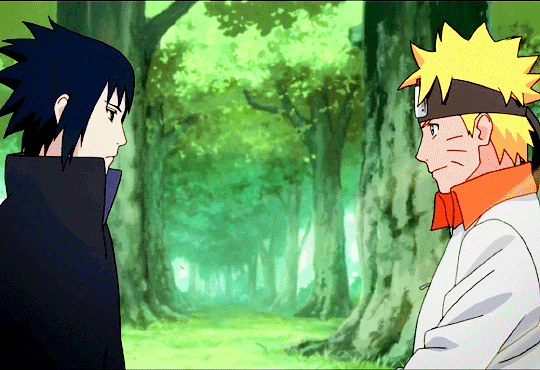
#sasunaru#narusau#naruto#boruto#love#sasuke xnaruto#saske uchiha#uchihasasuke#naruto uzumaki#naruto universe#medieval#samurai#naruto x sasuke#Narutolovessasuke#sasuke loves Naruto#medieval Japan#ninjas#kishimoto#valley of the end
55 notes
·
View notes
Note
Oh actually there’s running gag in how convenient that a lot of historical figures are in one game
AC syndicate is one of the most infamous, because despite it taking over a year. We meet Frederick Abberline, Charles Dickinson and Darwin(actually there a lot of tongue meta jokes with him. As his theory of evolution is still accurate in ac. He doesn’t know that humanity to primatesto what dogs are to wolves), Karl Marx (sadly you can’t kill him), Alexander Graham Bell, Nightingale, and the motherfucking Queen Victoria
Not counting dlc with Arthur Doyle and Deup Singh
And yes we do have dlc centered around Jack the Ripper
Oh shit I forgot there ww1 segment where you work with Winston Churchill
Another thing, so in the halo series, there a propaganda line of “Spartans never die, there just Missing In Action”
It took Herdotus in odyessy, yes the Father of History (or Lies to the Egyptians), saying that Spartan poem of them being immortal I went
“Wait that where halo got it from?!”
Actually leaks said William Adams is going to be in the game too. I presuming third act or late game, wait could Adams travel to other places after becoming a samurai? I can see him being used a mechanic to explain how we can go to other countries like India
Btw I meet Rolo of Normandy in Valhalla when he was 17…in a medieval bdsm dungeon while he blindfolded and wiped
Dear god Middle Ages England was truly the apocalypse
Also I only realize it after the endgame…young Rolo actually lives in my settlement for a bit
But yeah I can see them making up a relationship with Yasuke and William Adams. Oh another joke
A Japanese: another Gajin join us?’
Yasuke: Yes and make him a proper samurai this time
Oh this is Valhalla main menu theme. But rest to sure the ac red music will be authentic
https://youtu.be/bApSPN-5TxQ?si=FcMKeReMxCuxGpxW
Hell the teaser trailer I sent actually ends with the game Japanese cover of ac iconic song ezio family
Lots of stuff ending with
Oh shit I forgot there ww1 segment where you work with Winston Churchill
Doyle and Churchill don't quite fit, Deup Singh either but in the other direction
It took Herdotus in odyessy, yes the Father of History (or Lies to the Egyptians), saying that Spartan poem of them being immortal I went
“Wait that where halo got it from?!”
Josephus is a good historian to read too, and it's entirely possible that's where they got it, not sure the poem tho so can't say for sure.
Actually leaks said William Adams is going to be in the game too. I presuming third act or late game, wait could Adams travel to other places after becoming a samurai? I can see him being used a mechanic to explain how we can go to other countries like India
Ya Tokegawa let him go back to England even at some point, he had freedom of movement probably had to still have permission from the boss to leave Japan but well
List of foreign-born samurai (Yasuke doesn't make the cut because they can't 100% prove he was or wasn't a samurai.) but this list goes through their credentials or however you want to put it.
For Addams it was
250 koku. He was granted the rank of Hatamoto, a fief and 80-90 servants. Interpreter and shipwright of Tokugawa Shogunate.
Only one managed a higher worth.
Btw I meet Rolo of Normandy in Valhalla when he was 17…in a medieval bdsm dungeon while he blindfolded and wiped
Dear god Middle Ages England was truly the apocalypse
Not just in Europe either, though that's where we have the specific information about things, shit was bad in Asia, the middle east, and Africa too. Lots of those areas had the same problem too.
But yeah I can see them making up a relationship with Yasuke and William Adams. Oh another joke
A Japanese: another Gajin join us?’
Yasuke: Yes and make him a proper samurai this time
I take it Yasuke managed to pick up the language ok then, Addams did ok but still had a interpreter with him all the time too just in case.
youtube
Oh that's pretty
Hell the teaser trailer I sent actually ends with the game Japanese cover of ac iconic song ezio family
I didn't catch that apparently, that's cool af
3 notes
·
View notes
Note
Now I'm suddenly wondering: have you noticed any more obscure references to Japanese history and myth in Len'en (that you haven't already talked about)?
Hm, I suppose that'd depend on how we define obscure, there are still a lot of references that I haven't gone over yet, many of the EMS characters being ones that I can think of off the top of my head.
But today I guess we can take a look at one that I myself figured out not too long ago: Kujiru Kesa, slug youkai, faithful shikigami to Garaiya Ogata and omnipresent scout of the Dragonfly Army.

The Person Who is One, And Yet Many — Kujiru Kesa
Name: Kujiru Kesa
Their given name "kujiru" (クジル) is written in katakana but is likely meant to be the verb 抉る, "to stick (a rod, etc.) into and move around", "to dig/scoop something out" or "to pierce a hole into a hard object".
Their family name, "kesa" (袈裟), is the Japanese word for the Kāṣāya, robes worn by fully ordained Buddhist monks and nuns.
Sometimes when children are born, the umbilical cord is hung around the neck and body, which looks like the child is born wearing a Kāṣāya.
However, children whose umbilical cords wrap around them like this are prone to stillbirth, so those who are born like this often have "Kesa (袈裟)" added to their name, as a charm for peaceful growth. This relation to life and growth may be related to Kujiru's ability to divide and create more of themselves.
Mythological Basis: Kesa-gozen
Let's start with what I discovered recently, that Kujiru has roots in the fictional character (as far as we can tell) Kesa-gozen. Her story most famously found in The Tale of the Heike (平家物語), although other versions exist as well.
The Tale of the Heike
The Tale of the Heike, unlike the entirely fictitious The Tale of Genji, is actually based on history.
Specifically, it is an epic account of the struggle between the Taira and Minamoto clans for control of Japan, which ultimately ended in the Jōhei Tengyō no Ran (承平天慶の乱), more commonly known as the Genpei War (源平合戦).
You might know that this is also where we got our famous account of the Kusanagi sinking into the sea from, as well as where the Saeda is famously featured.
Kesa-gozen's Story
Kesa-gonzen's story really only superficially inspired Kujiru and there's not much need to be too detailed with it, so here's a condensed version:
A samurai by the name Moritou Endou (遠藤盛遠), who did historically exist, fell in love with Kesa-gozen (袈裟御前), the wife of his cousin, Minamoto no Wataru (源渡).
Depicted below: Moritou re-encountering Kesa, when he realises how beautiful she had gotten.

Unable to contain himself, he went to see Kinugawa-tono (衣川殿), Kesa's mother, demanding to meet Kesa, going as far as to threaten her with his sword.
Kesa wasn't willing to sacrifice her mother to save herself, so she agreed to meet Moritou. The samurai snuck in during the night and spent the night with her, but refused to leave when morning came.
Kesa then asked Moritou to kill his husband for her, telling him that she would wash Wataru's hair that night and get him drunk, giving Moritou the opportunity to kill him.
Moritou, overjoyed that Kesa had come to return his feelings, left to prepare for the night. Unbeknownst to him, Kesa would wet her own hair and sleep where Wataru usually slept.
Depicted below: Kesa-gozen preparing herself to take her husband's place.

Moritou snuck in at night and severed the head he thought belonged to Wataru. However, he had actually killed Kesa and she had sacrificed herself for her husband.
Motirou, in his grief, left home and became a Buddhist monk named Mongaku (文覚) to atone for his sin. It is as Mongaku that he would achieve his fame and warrant this legendry backstory.
It is said that a slug appears on his grave every year on the 9th day of the 7th month of the traditional lunisolar calendar, the same day Kesa-gozen was killed.
This slug is believed to be her soul, appearing to offer her forgiveness to Mongaku.
Ties to Kujiru
The name Kesa is obvisouly taken directly from Kesa-gozen, while Kujiru's existence as a slug youkai taken from the slug believed to be her soul given form.
Kesa-gozen's appearance in the Tale of the Heike, a story primarily focused on the Taira clan, may also explain Kujiru's appearance on the Youkai Alliance's side of the Heaven-Shadow War, which has heavy ties to the Taira of Mugenri.
As a side note, one might notice that Kujiru is actually pretty superficially inspired by Kesa-gozen only, when compared to a lot of the other characters.
My personal guess for this may be that JynX simply wanted a slug youkai in the first place, to drive home Garaiya's reference to Jiraiya (more on this someday). Then searched for a legend that they could've based another slug youkai on, hence.
Although it's just as likely that there's more to Kujiru that we simply aren't privy to yet, or that JynX simply didn't want to be so heavy handed this time.
Ending
And that's really all I have on Kujiru!
There's not too much we have on Kujiru yet, what with them just being a stage 2 character and having just debuted, but we'll definitely get to see more of them in BPoHC -GC-, so let's look forward to that!
There is technically more to say in regards to their ability and how it relates to them as a shikigami, but I think that's better suited for an analysis of "shikigami in Len'en", rather than on Kujiru as a character.
Nevertheless, this is certainly obscure enough, or so I personally think. I hope you enjoyed all the same~! :)
#len'en#len'en project#len'en lore#kujiru kesa#as a fun side note#while we now know that Kesa-gozen almost certainly didn't exist and that the entire story was made up#people in the past did genuinely believe in her existence#she was even hailed as a perfect example of filial piety and loyalty to one's husband#and had her own grave erected at the temple Mongaku died in#where she is deified as an avatar of the bodhisattva Kanzeon
15 notes
·
View notes
Text

(little tired today, so instead of doing replies rn, have a lore/headcanon post that also doubles as a pride post for the OCs - explanation of name meanings and why they were chosen, if applicable)
Rio's first name is written as 莉桜 - the character for jasmine and the character for sakura/cherry blossoms. Her name can also be read as "Risa," although that mistake annoys her in its frequency. She went through a lot of potential names before settling on 'Rio,' but eventually picked it because she liked how it looked in both Japanese and in English. There wasn't a ton of significance to it outside of just enjoying how it looked and sounded. That said, it does fit decently well with her last name, since Fujioka (藤岡) is made up of the characters for wisteria and hill, continuing a floral motif. Fujioka is not her original last name, but is actually her mother's maiden name, since the uncle who adopted her is her mother's younger brother.
Izumi's first name is written as 泉水. It's a word on its own, meaning a fountain or a small pond or lake. The characters that make it up mean "natural spring" and "water," and Izumi's thinking was that a name that evoked a sort of gentle, pleasant, undisturbed fixture would help her come across as calm - this did not work. She'd also considered just choosing "Umi" with the character for the ocean, before deciding that people would make fun of her for it. Her last name, Ueda (上田), is a common last name that means "above/over" and "rice field," and likely has some connection to her family's historical livelihoods, place of living, or both.
Tsubasa's first name is written 翼 and means "wing." As a name, it can be read a lot of ways, but 'Tsubasa' is one of the more unisex ways to read it. As a cyber angel, Tsubasa naturally has digital wings, and on their skateboard, they're practically flying anyway, and thought that it was a good fit. They have an official last name in their family register, but they choose to write Saiba in katakana instead. Saiba IS a real last name that can be written in kanji, but Tsubasa writes it in katakana as a stand-in for the English word "Cyber."
Anzu's first name is written 杏子, which is the character for "apricot" and the character for "child". It can be read a variety of ways, with "Kyoko" as the most common other reading. In Anzu's case, there were two main points of importance - that her name would help people remember her, and that it would sound nice with her last name. Because her eyes are that sort of yellow-orange color, it's a good match, and if you find her eyes striking, you'll probably remember her name. Tachibana (立花) means "standing flower," and historically has associations with a particular samurai clan. In Anzu's case, her thinking was that a shorter, two-syllable first name worked best after a longer, four-syllable last name. Her stage name, Kohaku Goto XII, also typically has kanji and meanings associated with it, but, breaking with tradition, Anzu writes it in hiragana, or in English characters.
Shinobu's first name is written 志信, made up of the character for "aspiration/aim" and the character for "devotion/faith". It isn't a common way to write that name at all, but Shinobu chose it as a self-reminder to stay devoted to her goals. As Shinobu has mentioned, the ancestor who started their dojo was an orphan, and the name Yaguchi (矢口) was probably one that either he chose or was given to him, rather than his hereditary name. It's made up of the characters for "arrow" and the characters for "mouth/opening/entrance," and was likely chosen specifically in reference to the budding dojo.
Kousuke did not choose his name, which is written as 光佑, but he still tries his best to live up to it. It's made up of the character for "light" and the character for "help/assist." It's not an especially common spelling of that name, and he fairly commonly has to explain how it's read to teachers. Minami (南) is a very simple last name that just means "south."
Likewise, Kiyomi didn't choose her name, written 季世未, and is a little embarrassed about the spelling. Spoken aloud, her name isn't that unique, but the chosen characters are... pretty unusual. It's made up of the characters for "season," "world/society" and a character that doesn't have a direct meaning but can be interpreted as "still" or "even now." As such, Kiyomi has taken to writing her name in hiragana, and lying that she doesn't have kanji for it. Her last name, Kita (北) means "north" and it's Kiyomi's theory that her mom was worried she wouldn't stand out with a "plain" last name, thus leading to the unusual spelling of her first name.
2 notes
·
View notes
Note
Hi Vyra!
I adore your art and I found you a few years ago, when you were the only one who liked Limbo while everyone else hated him. So I was very happy to find another soul who loved him just as I do :)
Since we share the same tastes, I wanted to ask, what are some mangas that you like? I’ve recently picked up The Ghost and the Lady and I LOVED it! And I vaguely remember that you did answer an ask that was a little similar to this but I couldn’t find it and I think my memory could’ve been off.
Thank you and have a great day/night!
🥺
zomg....first of all thank you for such a sweet message and yes
GHOST AND LADY IS THE BEST, ONCE AGAIN, I HAVE THE VOLUMES ON MY DESK LITERALLY IN EYESIGHT CAUSE THAT'S HOW IMPORTANT IT IS
from same author you have, karakuri circus (found family, powerful) and souboutei must be destroyed (can't pinpoint how to describe it other than my friend fucking read all chapters in two day more mere mention, it has it all)
in the same genre of, mystery horror surrealist weird loving emotional focusing on the bonds of people through horror
i will never stop reccommending demon detective nougami neuro, same author as assassination classroom but i'm a purist, it was the first ever manga i read too so it's very important to me in general if familiar you can imagine how this author is comedy horror and bizarre but never strays from the most humane feelings, i will now recommend his newest work and currently published ELUSIVE SAMURAI. it's historical drama this time and fucking honestly, goes just as hard and the research is thorough as well while having the surrealist comedy, real fucking good (+ neuro is without a doubt one of the main inspirations of the Great hasendow)
dorohedoro because it's dorohedoro.
magilumiere co (adult corporate magical girl, really fuckin well done)
daisuke igarashi's saru fucked me up but i'm not sure you can find it easily which sucks, i don't even have the volumes myself
i haven't read much recently actually but that should be it!
6 notes
·
View notes
Text
There's an elephant in the room...
With my re-read of Peacemaker Kurogane, I started to lurk in some old forums and communities in LiveJournal that were created back when the series was climbing on it's popularity, and there's a topic in particular that called my attention due that it was also speculated here on tumblr. A topic that may had been hinted in the manga, and that lead to a shocking theory.
Who killed the Ichimura family?
The simple answer would be Yoshida, however, because one particular line before he almost killed Tetsunosuke, many people have speculated that he wasn't the killer, and instead, shift the blame on Hijikata given their similar physical appearances.
There's a lot to unpack here.
Where the doubt started?
It all started in chapter 27 of Shinsenfumi Imon Peacemaker, when Tetsunosuke confronts Yoshida for not killing him two years ago:
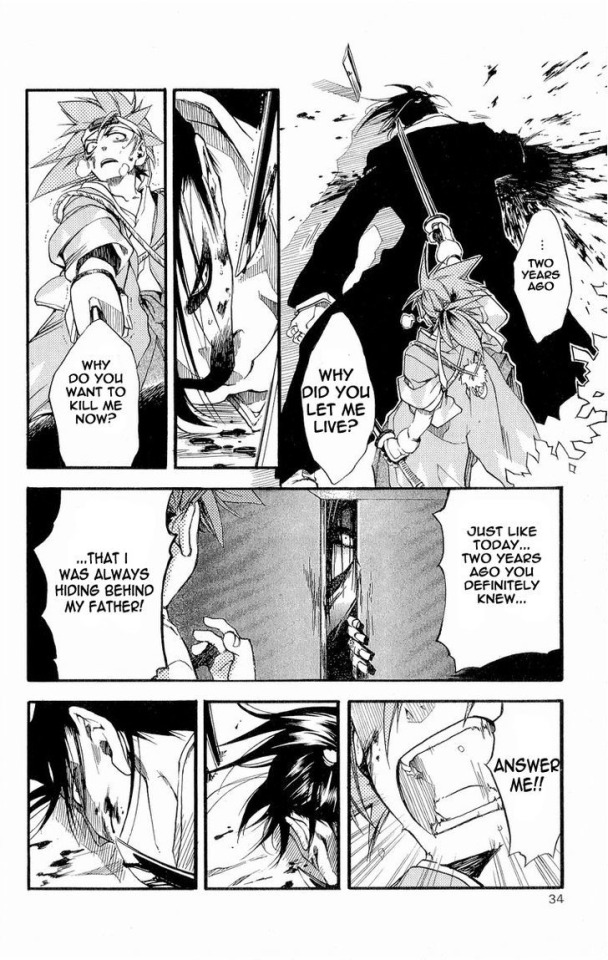
Yoshida replies this:

And then in chapter 16 of Peacemaker Kurogane, when Sakamoto Ryoma informs Katsu Kaishuu that the Ichimura brothers made it to the Shinsengumi, Katsu says this:

....which indeed creates a big question: did Yoshida really kill the Ichimura?
The reason why some people place the blame on Hijikata is that he physically resembles Yoshida and because he does seem to recognize the Ichimura surname in the very first chapter of Shinsengumi Imon Peacemaker and knows that Tetsunosuke is here for revenge:


This indeed looks so suspicious.
Later on Peacemaker Kurogane we do have some "hints" that Hijikata had to do something in order to help Kondou to become a samurai, we see this in chapter 56, the same one where Hijikata goes to Katsu Kaishuu to asks him to help him save Kondou's life:
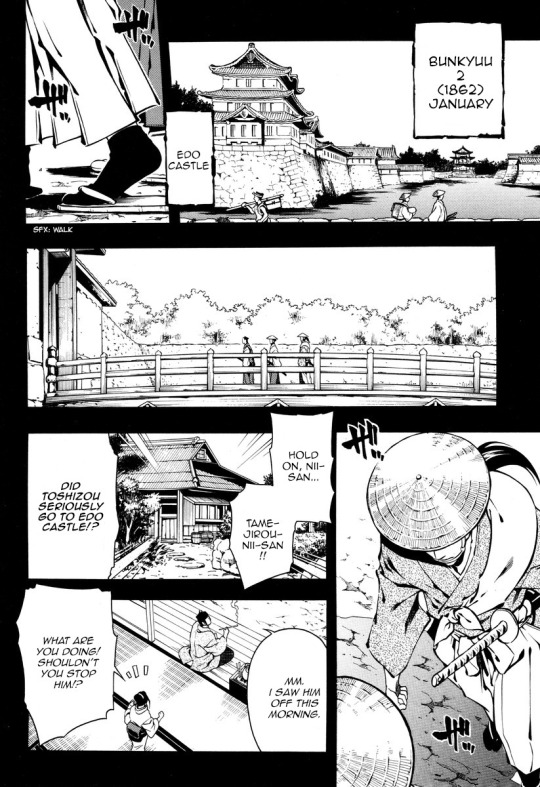
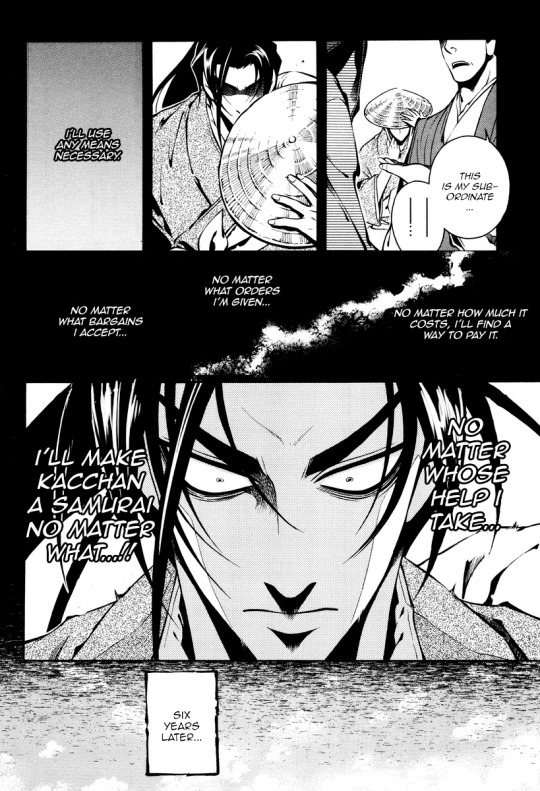

1862 was the same year Tetsunosuke's parents were killed, Hijikata says he'll do "anything" to make Kondou a samurai, and Kondou later reflects that "he doesn't has to do regrettable things for his sake, as he did back then". What thing Hijikata had to do in order to make Kondou a samurai? Why there's so much mystery surrounding it? Part of me, is fearing the worst.
However, on the other hand, while the theory does has it's substance, there's a lot that wouldn't make sense of it, both from a historical perspective AND a storytelling perspective, in my humble opinion.
Historical perspective:
The Shinsengumi didn't started to be active until 1863, when they were called the Roshigumi.
In the manga, is said that the Ichimura family was murdered "two years" prior the beginning of the series. The story starts in March 1864, which means the Ichimura parents were killed in 1862, when they lived in Ōgaki (for all the liberties Chrono took with Tetsunosuke's background, he did kept the fact he was born in the Ōgaki domain). In 1862, if my memory isn't mistaken, it was when the Shinsengumi started to be recruited only for them to travel to Kyoto and start working the next year. Hijikata was still a medicine peddler living in Edo - wouldn't make much sense he would travel to Ōgaki to assassinate ONE person, unless Chrono really wants to take a bigger liberty in the story - though for what we see in chapter 56, it all points out that Hijikata was in some sort of activity by the Shogunate at the beginning of 1862, but even so, something doesn't makes sense.
Another thing is that, just because there were people who wanted the Shogunate to go out, that doesn't means they all aligned with the same methods or ideas. Now I admit that this part isn't my strenght because I'm not too knowing in Japanese history, but there's a reason why the Choshuu and the Satsuma needed Sakamoto Ryoma's mediation in order to become an alliance, didn't they? (If someone knows more about this please comment!). That Katsu Kaishuu and Sakamoto Ryoma in the manga knew it was time for the Shogunate to end didn't meant they actually would had approved of the attacks against foreigners by radicals (though as a fun fact, the historical Ryoma actually TRIED to assasinate Katsu Kaishuu before they became allies, but I'm sticking here to the manga characterizations because comparing the historical vs manga portrayals would be a topic for another post).
There's also the fact it's said in the manga that Tetsunosuke's father actually had the support of the Shogunate, he was a translator who went with the first embassy from Japan to the USA, so it doesn't makes any sense that they would had ordered to kill an officer of their own who as far as we know, didn't had any anti-shogun ideas, specially when lots of discontent against the Shogunate started by how it dealt with the opening of the country and the entrance of foreigners.
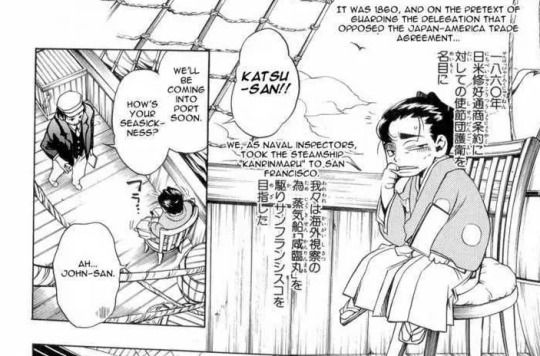
This is when Katsu Kaishuu recalls meeting Tetsunosuke's father, who worked as a translator. Sakamoto later confirms this to Tetsunosuke in chapter 20.
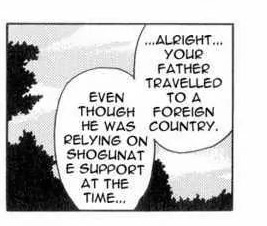
However, this does fits much better with the official narrative presented in the manga that Tetsunosuke's father was killed by a Choshuu radical who hated foreigners, specially when those incidents did happened in real life (not to Tetsu's father, but to other collaborating Japanese):
" From 1859, the ports of Nagasaki, Hakodate and Yokohama became open to foreign traders as a consequence of the Treaties.[19] Foreigners arrived in Yokohama and Kanagawa in great numbers, giving rise to trouble with the samurai.[18] Violence increased against the foreigners and those who dealt with them. Murders of foreigners and collaborating Japanese soon followed. On 26 August 1859, a Russian sailor was cut to pieces in the streets of Yokohama.[18] In early 1860, two Dutch captains were slaughtered, also in Yokohama.[18] Chinese and native servants of foreigners were also killed.[18]" (source)
(Not a fan of quoting Wikipedia, but I don't own any book of Japanese history that I can use as a source. Again if any of you do please please comment and add your thoughts so you can enlighten me and the rest of us!!!)
Okay, so that's the historical perspective, now what about the storytelling perspective?
Storytelling perspective:
It's very well established in the manga that Yoshida hated foreigners, loved to set things on fire and even planned to participate in the great Kyoto fire to the point that Katsura Katsugoro, the leader of the Choshuu, told him to just stop. (chapter 13 of Shinsengumi Imon Peacemaker)
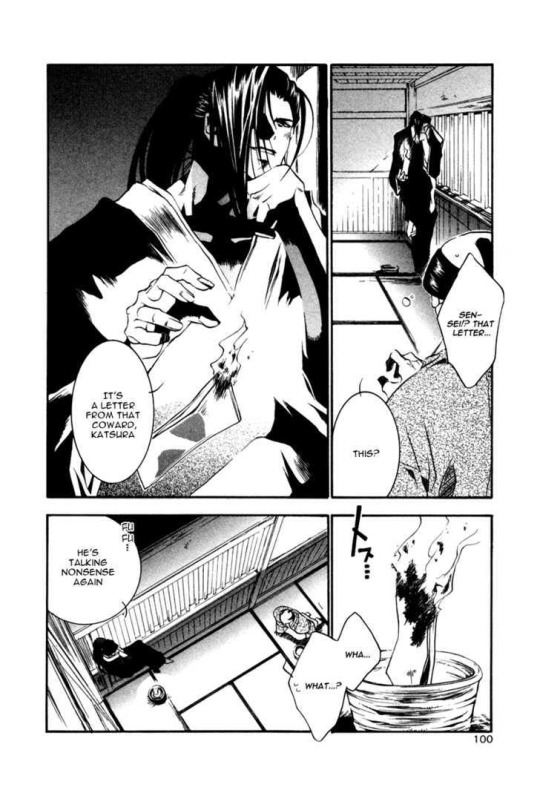
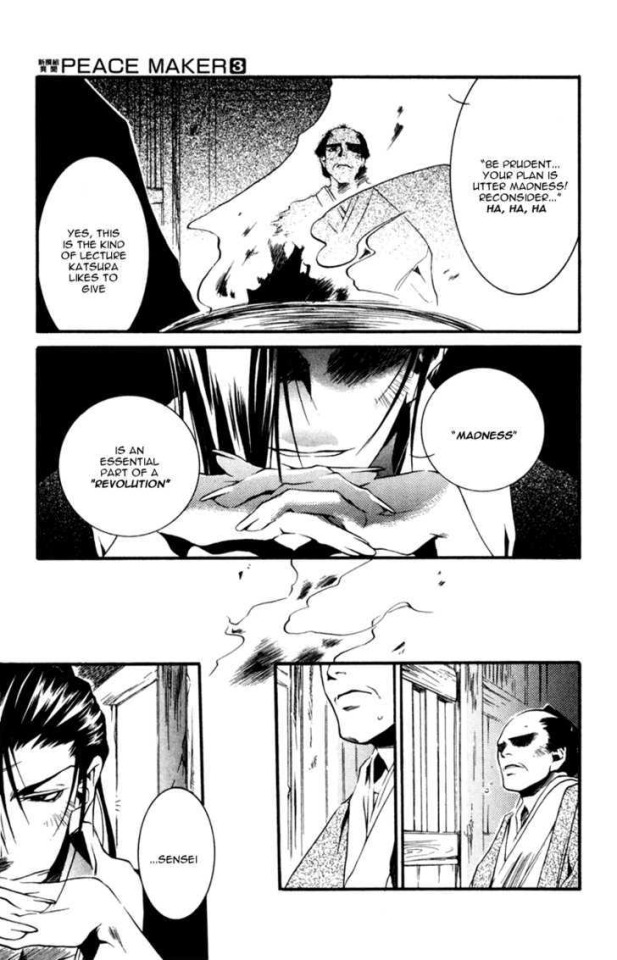
Hijikata even recalls this about him chapters earlier:


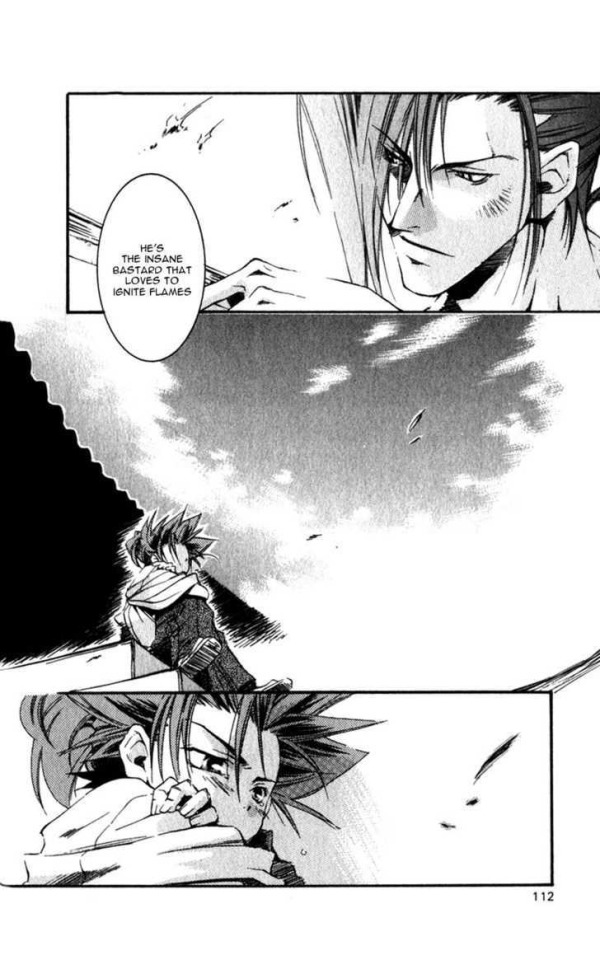
On the other hand, we know from the first chapter that even if Tetsunosuke doesn't knows Yoshida's face, he does recall his eyes! If Hijikata was the actual murderer....wouldn't had he recognized him by looking at his eyes?
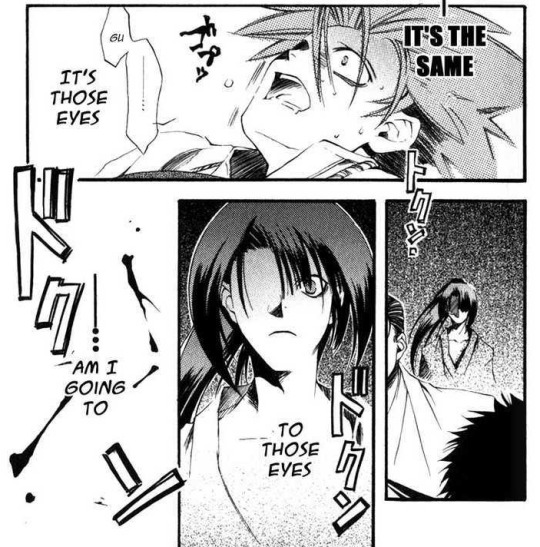
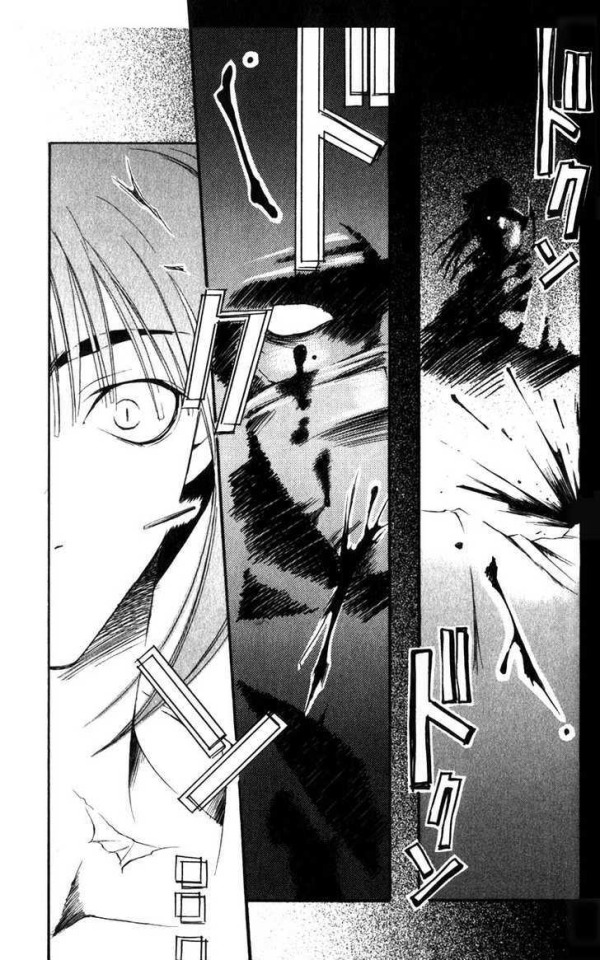
Instead, Tetsunosuke seems immediately recognize Yoshida BEFORE he even knows he's a Choshuu rounin, and Yoshida seems to recognize him as well upon hearing the surname Ichimura and seeing the strong physical resemblance between Tatsunosuke and his father. Otherwise, why the heck would had Yoshida wanted to kill Tetsunosuke? And by the same method that his parents died?



So yeah, I actually believe it was really Yoshida who did it, and the reason why he didn't knew what Tetsunosuke was talking about was because he didn't knew he was hiding, otherwise he would had killed him on spot.
Personally, if Chrono ever pulls out that it was Hijikata and not Yoshida, it would feel more like a plot twist just for shock value, because as pointed in the arguments above, it doesn't makes sense both from historical and storytelling reasons. Futhermore, it would tarnish Hijikata's image (yeah, we know he was ruthless, but to let an innocent child burn to death would be crossing the line) and it would made Suzu's tragedy even more unfair than it actually is. Suzu went through a lot: he starved and sold himself to survive after his master died, to the point he became mentally ill as a result, so if Yoshida at the end wasn't the one who killed the Ichimuras and Tetsunosuke seeked revenge on the wrong guy, then it would made his story the double of unfair than it actually is. Suzu's story is meant to shown Tetsunosuke that with revenge there are always innocent people who by association end paying the sins of those who commited it, and to not have Yoshida being the murderer it would be...well...pretty bad.
As for why Hijikata heard about the Ichimuras...maybe they were informed? Or he found out when researching about Yoshida? I feel like if he was the actual killer it would had pop up often in his mind. After all, we know his actual desire to protect Tetsunosuke is rooted on his own guilt for what he did to Souji in the past, that's why he feels responsible about him. The foreshadowing in my opinion would had been stronger, like the foreshadowing that Tatsunosuke was the Shinigami - which was a given way before it was revealed in recent manga chapters.
So...here are my thoughts on the matter.
5 notes
·
View notes
Note
Not sure if you explained this before but what inspired you to use the IRL Yuuki clan as Amaya's backstory?
This is going to go back to the original conception of LR.
It may come as a surprise, but Amaya was originally the Sakamaki's sister (how original, I know lol). I was just too lazy to think up of an original family name since it was just me playing imagination in my own head at the time. But eventually, I couldn't stomach being related to them anymore and tried to think up an original backstory.
I always thought the Sengoku period and historical samurai fantasy was cool so I knew I wanted something like that. I actually had a very vivid image of Amaya fighting on a snowy battlefield, which became my launching point.
I also mentioned that I stole "Yuuki" from SAO because I liked how it sounded, and how it was a homophone for "courage". I was originally trying to come up with my own kanji for it, and while internet surfing around for ideas, I found that "Yuuki" was an IRL samurai clan. There's not a lot of info since they aren't that prominent compared to the usual Sengoku historical figures, but you'll find most of what I referenced by looking up "Shirakawa Castle" or "Komine Castle".
I'd already come up with the idea that the main conflict would be surrounding Amaya's position as a female heir, and that Krul would turn her into a vampire so she could stop an invasion to protect her home. But, I hadn't set any details in stone yet.
Oddly enough, what vague info I could find fit into this initial idea perfectly and with more research, all those details just fell into place.
Of course, LR's depiction of the Yuuki-Komine conflict, what led to the battle with the Ashina, the Yuuki's allegiance with the Date clan, and their dispossession by Hideyoshi were all completely made up. While these things did happen in real life and my version of events was just filling in the gaps of the info I found, I'm sure the real reasons behind why they happened were very different, haha.
I wrote my story in a way that was consistent with the information I found because I wanted to be historically accurate so it would sound believable. (Unlike actual dl's.....questionable historical references at best....) I actually chose my university classes around what I thought would be useful in writing LR. 😅 (This included a crapton of Japanese history classes)
But of course, the accuracy only goes as far as what I needed to tell the story I wanted. Many artistic liberties were taken. So goes without saying, but don't use LR as a history textbook lol.
In the end, I just had always wanted to read a Sengoku historical fantasy story with a heroine like Amaya, so that's what I wrote!
4 notes
·
View notes
Text
The American Cowboy

The actual American cowboy was indeed a unique individual. While probably not as noble and ruggedly handsome as the images created of him in the movies, they were unique types of men who carved out a civilization from the rugged wilderness that was the American west in the years before the turn of the last century.
African Americans Revolution Academic Research Paper Pdf
Some of the reasons that the image of the cowboy sometimes includes elements of the outlaw and the loner is that much of the legend of the cowboy came from stories of refugees from the broken southern army who took to the life of the cowboy rather than attempt to integrate into a society that included making peace with “the Yankee”. And that type of individual certainly did account for many of the outlaws who went on to become the stuff of legend and stories even to this day.
The renegade and loner image combined with the rough life of an actual cowboy whose job it was to guide those huge herds of cattle along trails such as the historic Cumberland trail where they could be sold to become the steaks, leather and other goods that were sold in rustic American stores of the time. This was a difficult life and the stories of the trail make up many history books for sure. But far more of the stories of the trail are glorifications of that lifestyle that must have been difficult indeed.
But the image of the cowboy was also something that grew larger than what the actual lifestyle of those simple but rugged men must have lived in the American west. It was an image that pulled together heroes as far flung as the Australian Gaucho cowboy, the Japanese Samurai and a knight in King Arthur’s court. It was an image of a man who demonstrated the rugged individualism that all Americans consider to be one of the central unifying traits that makes America great.
The cowboy image is one that even has its influence as high in the social strata of America that it influences the presidency. It is said that there is a tradition for any president when he first is elected and comes to Washington to begin learning this big new job. Tradition h olds that each president has as part of their early duties to sit down and watch the movie High Noon. They say that President Clinton watched it dozens of times in his early years. If this is true, it accounts for how often a new president seems to grow and change in the office and becomes his own version of the great American hero that is depicted in that movie. The American cowboy defends the virtue of the weak and helpless. He is a staunch defender of families and those in society who are trying to carve out a home in a difficult world. As such, the American cowboy fits with the “superhero” image that also appeals to the American system of justice and morality and values.
Even the star wars epic films were fundamentally grounded in the legend of the cowboy. The cowboy concept grew up from a history of our country that included the settling of a big land and the settling of a wilderness that pit the god given will and intellect of man against God’s creation. And it was the will of man that prevailed. That is why American’s admire the cowboy because he represents their own struggles for greatness, for success and to be a heroic figure at least for their families, home towns and churches. And that desire so deeply rooted in the culture of American history will always be what makes America and Americans great.
African Americans Revolution Academic Research Paper Pdf
0 notes
Text
This is just a huge long winded post about how Germa reminds me of Japanese history and mythology, and some Wano things. Just so that it's all in one place and not scattered.
Very wild and goes all over the place, it's that conspiracy board with strings. I've been enabled by enablers.
WCI:
Related to the Nobunaga post (you probably need to read that one first).
Deep, deep reach here, and I feel like it's just bonkers connecting WCI to something as historically significant in Japan as The Honnouji Incident, and it doesn't even seem relevant at all. But. It was well known that Nobunaga was killed on the verge of reaching a big success.
He was on his way to oversee reinforcements being led to fight one of his biggest rivals, and anticipating that this will finally bring them down. Then one of his commanders betrayed him and he died with his heir. On the night before his death, he was having a glamorous tea party with the court nobles, not suspecting that anything was wrong.
Germa thought they were going to secure a big profit by allying with Big Mum, but are betrayed and they all almost died in a tea party where many VIPs from all over the world were present.
There's a lot of rain during WCI. I think it's just meant to relate to Sanji's mental state, because rain = sadness is a very common trope.
Still, very famous conspiracy related to the above historical incident was that the commander who did the betrayal was said to have written a poem that has the line translated something along the lines of "Now, the rain falls, on the fifth month" before committing the deed. This poem supposedly contains a hidden message that reveals his intention to betray.
Like I said the connection is very flimsy, that's why I doubt there's relevance.
Also in terms of more number 6 stuff, the above incident happened in history in the sixth lunar month (also in June, according to Western calendar).
Japanese crests:
More randomly throwing nonsense at the wall, but speaking of Japanese tradition, Ichiji's belt somewhat reminds me of some samurai house crest. I had been thinking about this a lot since I've been going through traditional Japanese designs in making the youkai AU:


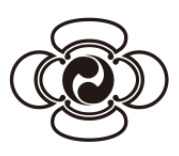
And on the subject of Japanese designs, "lightning/thunder" is actually traditionally depicted as a "square spiral". In patterning (like clothes or paintings), it can sometimes be embellished into a shape that vaguely resembles a swastika.


I just thought the swirly pattern is interesting. It's square, while Sanji and the others are round spiral shapes, so it might not be relevant. I just thought of this because of the lightning bolt in the Germa skull.
Wano:
Also. Probably just design coincidence, but... somehow their silhouette is similar (same big fluffy hair, the coat's cut flares like a kimono):

I mean, not saying the Vinsmoke family is related to the Kozuki, just the Wano people in general. I mentioned once that I thought young Judge kind of looks like young Kin'emon.
Last thought. There is a conspiracy in Japan, where famous warrior Minamoto no Yoshitsune didn't die like history said. He actually went to the mainland and became Genghis Khan.
This was part of what I was thinking, when I thought the Vinsmokes might have Wano origins. It's a story of "Japanese hero leaves Japan, becomes a ruler elsewhere".
Other random things that are probably even more not relevant, but doesn't help my conspiracy brain:
One of Nobunaga's sons who survived the chaos ended up in service of the conqueror who succeeded in unifying Japan, Toyotomi Hideyoshi (apparently according to Japanese text it's not Tokugawa like people think). This Hideyoshi is famously nicknamed "Monkey" in Japan (regardless of whether this is true or not)
Said son is infamous in Japanese perception for being "stupid" and "useless" because he is just absolutely terrible in warfare (not sure if this is necessarily true either, but well, I'm no historian). He's apparently very good in the arts, though.
In the linked post I mentioned of there being another son whose name is literally number 3 and 7 (Sanshichi) that makes me just giggle because of Sanji being 3 and 2. That third son is not the one who survived, but this one and his older brother was born so closely in timing (from different mothers) that people have argued that the order of the birth was incorrectly recorded.
Those two brothers were sometimes said to have issues with each other because of this. I don't think this is relevant, but this knowledge just makes Niji and Sanji's interaction seem funny to me.
14 notes
·
View notes
Note
Hello! 👋 I wanted to say that your posts are getting more and more interesting!
Thinking about it anf thanks to your research I realized how much thought really went into the game with details that many people would easily miss like the significance of family crests.
Talking about crests I actually have a small question : Historically speaking, was having your family's crest on your clothes an actual thing in Japan at the time?
Thank you so much for your efforts, looking forward to your future posts! 😁
(Spoilers for TGAA2 within!)
First of all, thank you for the kind ask!! It's really nice to hear you're enjoying all the details the game has to offer. That's part of the reason I wanted to do this - to extend my enjoyment of the game by unpacking as much detail as I can, and to hopefully do the same for others. That post I reblogged was very helpful to me too, and I'm glad I could add to it a little.
To answer your question: yes! People did indeed wear their kamon (家紋, family crests) on their clothing, most commonly on their chest, sleeves, and back. But they weren't a common part of everyday clothing, perhaps because the process required detailed work that only certain craftsmen could do. Yujin's outfit in particular is a very formal getup know as a montsuki haori hakama. Montsuki = crest-bearing, haori = jacket, and hakama = the trouser-like garment he and Susato wear.


(Photo from here)
However, I couldn't find any hakama with a crest on them like Susato's. Men's hakama are either solid or pinstriped, while women's are either solid or ombre. While they were sometimes embroidered, it doesn't look like crests were used to decorate them.

Auchi's upper-body garment, known as a kataginu, was one part of formal attire for samurai that also often featured crests. Auchi's has the kanji for the A in his name (亜) where a crest would normally go.
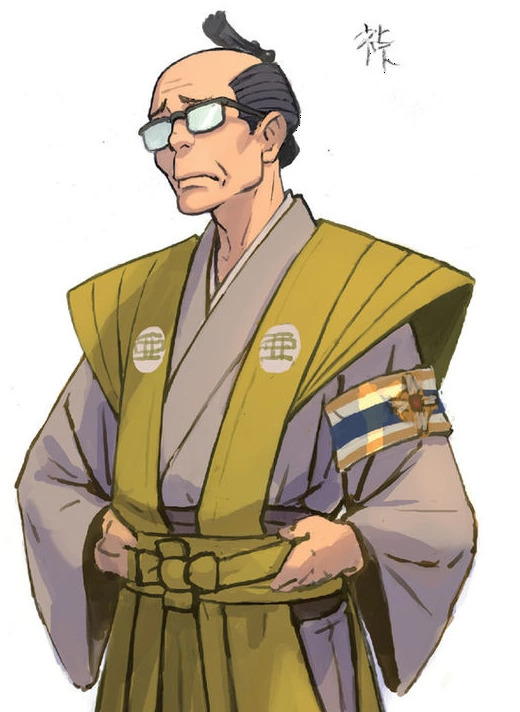
And here's a real kataginu for comparison. That white circle in the middle is the crest on the back:
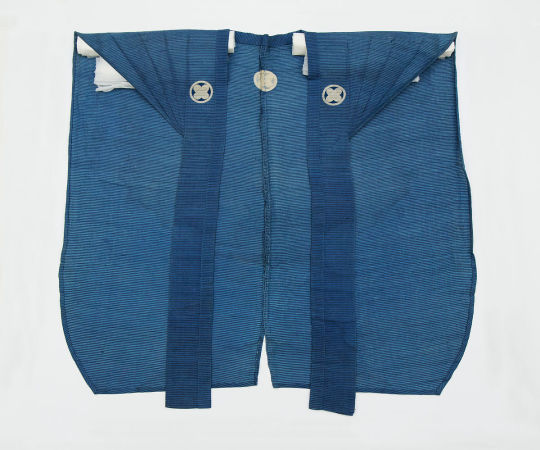
(Source)
A super-brief summary of crests (mon, 紋): the practice started somewhere around the 12th century, used only by the aristocracy at first. Warriors soon realized that they were useful for distinguishing between clans on the battlefield, so they adopted the practice to mark their banners, tents, and clothing. The practice was restricted to samurai and aristocracy for a long time, but by the Tokugawa Era, even ordinary citizens could adopt crests. In addition to clothing, crests could also be found inside the home, on storefronts, carriages, personal belongings, and tombstones.
In terms of fashion, the Meiji Era was an interesting one. People easily switched between Western and traditional attire, wearing suits one day and and kimono the next. As more people adopted Western fashion, crest-bearing outfits became less common. I don't know how historically accurate this is, but suit!Yujin wears his crest as a tie clip, which I think is very cool of him:

To close on a nice fun angsty thought: people could also wear the crests of their employers or patrons. We know that Yujin took Kazuma in after Genshin's death, so even though Kazuma is from a samurai family with its own crest, he may have had the option to wear the Mikotoba crest.
Hit me with follow-up questions any time!
Other Sources
Enchanting Edo: Craftsmen strive to protect 'kamon' family crest for modern Japan and world
#tgaa meta#dai gyakuten saiban#the great ace attorney#dgs spoilers#dgs2 spoilers#tgaa spoilers#tgaa2 spoilers#tgaa#dgs#asks#japan
61 notes
·
View notes
Text
Yea my third OG post! Sharing my discoveries and thoughts is a lot for me.
I mentioned GinTama’s author interweaving historical figures with the fictional characters. I just wanted to share some of my favorite manifestations.
Nagakura Shinpachi / Shimura Shinpachi
Shinpachi was modeled after Nagakura Shinpachi, who was the former captain of the 2nd troop of the Shinsengumi. However Sorachi scrapped the idea of having the character along the Shinsengumi, to have him be part of the Yorozuya in Gintama’s Odd jobs trio.


The name Shimura came from the late comedian Shimura Ken, whose humor is said to be the influential force behind Gintama.
Ryōma / Shimura dynamic influence
Real life Sakamoto was the youngest child in his family. He had three older sisters and a brother. His mother died early in his childhood, and his father before he was fully grown, so his siblings brought him up and continued to be the elders in his life. The biggest influence in his life was his sister Otome, who was said to be a dynamic woman. She was tall for Japan, did archery, horseback riding, etc. and worried her younger brother was a wimp. Incidentally, people believe she and Ryoma may be the dynamic relationship Otae and Shinpachi share and were modeled from. Stories include her pushing Ryoma into a canal to teach him how to swim and when he had a problem with bed wetting, hanging the bedding up on display publicly to shame him out of it. These are legends so it’s hard to verify. However, he did love his sister for raising him hard when he really needed it in his life.

At 12 and being bullied at school Otome enrolled him in a fencing school and he took to THAT like crazy. He grew up into a very good swordsman. And got permission to go study swordsmanship at Edo. A lot of young samurai from all over the country met and sparred within Edo. Sakamoto did so well he became an instructor at the Chiba dojo, one of the top three fencing schools in Edo.
Katsura Kogoro / Katsura Kotaro



During his time there he fought and lost against Katsura Kogoro, the chief instructor at another of the top three. This is why GinTama’s Katsura seems very astute during his younger years as a student.
Mutsu Munemitsu
Ryōma Sakamoto got into business. He was running the Kaientai, trading and shipping company and private navy, considered to be the first corporation in modern Japan. Sakamoto has some backing from Tosa domain for the project, but it’s an individual shipping company. He has on board people like young Mutsu Munemitsu (a young diplomat).

A man in real life, a woman in Gintama.

A small long story-short:
Sakamoto goes in battle against the shogunate. Things go well and he’s back in Kyoto and he’s back with his wife at the inn (where a famous raid takes place) and after goes into hiding with Oryou, whom he announces his marriage to, out of Kyoto to Satsuma in South Kyushu to recuperate. The next exciting thing to happen to him, his Kaientai ship is crashed into and sunk by a bigger ship belonging to Kii Domain. The most exciting bit of the story he wasn't actually involved in, though legend attached his name to it. The Kaientai sailors were getting sick and tired of sharp tongued Mutsu Munenori's attitude, and thought the crash was the perfect opportunity to murder Mutsu. Another of the Kaientai officers talked them out of it, saving Mutsu's life, but the story ends up being attributed to Sakamoto in all fictional versions, including Gintama's version.

The series had me fascinated by Ryōma Sakamoto. Gintama’s OG cast is influenced by Rurouni Kenshin, all the same Sakamoto’s life gets split into segments making very intriguing dynamics. Sakamoto’s life after meeting Otose & Oryou post war is being lived by Gintoki. His childhood upbringing was displayed by the Shimura siblings, yet aspects of his famous love story with his wife Oryou are dispatched to Otae. The real Sakamoto’s business ventures stayed with the invented Sakamoto throughout the series. It’s awesome to see how Sorachi’s came up with some of his ideas and concepts for his series. Lol this was fun. I want to do a part 2 of spoofs and interesting bts bits of character backgrounds. It may give international fans some insight into Japanese history. And may help give perspective to where Gintae peeps are coming from. Plus I think it’s getting me out of my shell a little bit. ✌️😚

Art by: Gintama10soul (twitter) 🖼
34 notes
·
View notes